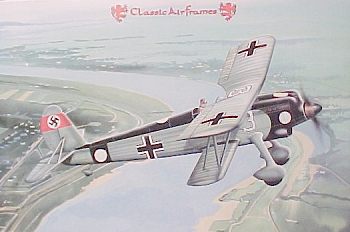 |
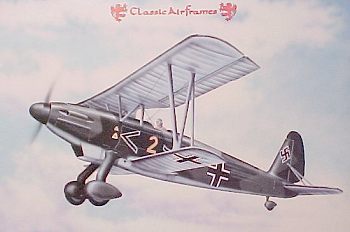 |
|
KIT: |
Classic Airframes 1/48 Ar-68E/F |
|
KIT # |
450/451 |
|
PRICE: |
$29.95 |
|
DECALS: |
Four aircraft |
|
REVIEWER: |
|
|
NOTES: |
Short run |
 |
 |
|
HISTORY |
There is a old saying in aviation design, that "if it looks right, it is right." This is largely true, though there have been several highly-successful exceptions to the rule, of which one of the most famous is the F-4 Phantom. (Obviously, the reviewer was slightly delusional when he wrote this statement. Ed-who thinks the Phantom II is one of the best looking aircraft around.) One of the lesser-known - though still successful - exceptions to this rule was the Arado Ar-68, which was destined to be the last fighter biplane to see operational service with the Luftwaffe.
Arado had produced the docile Ar-65 on which the first Luftwaffe fighter pilots cut their teeth in "publicity squadrons" which would later become the basis of the Jagdflieger following the announcement of the official existence of the Luftwaffe in 1934. While Heinkel produced the He-51 and became the supplier of the first fighter for the official Luftwaffe, Arado hoped to produce the successor to the He-51, basing their plans on the use of the Junkers Jumo 210 series inverted-vee high-powered engine which was supercharged and could maintain takeoff power to 11,500 ft, making it far superior to the BMW VI engine that had been the powerplant for the Ar-65 and the He-51.
When the first prototype took flight - powered by a BMW VI - in early 1934, it demonstrated superiority in handling and maneuverability, though the underpowered engine did not give it significantly-improved performance over the Ar-65. When a prototype Jumo 210A was installed, performance was significantly improved. Arado believed they had a winner and expected a production contract.
However, Luftwaffe pilots trained on the forgiving Ar-65 were experiencing difficulty with the less-forgiving He-51, and it was expected the Ar-68 would have even higher approach speeds and be even less-forgiving than the Heinkel.
Ernst Udet, the Inspector of Fighter and Dive-Bomber Pilots, tired of the official vacillation over the Ar-68. He scheduled a flight competition between himself in the Ar-68 Jumo-powered prototype and an experienced Luftwaffe pilot in an He-51. shortly after takeoff the outcome became pre-ordained. Udet out-maneuvered, out-climbed, out-turned and out-fought the he-51 decisively. The future of the Ar-68 was assured and it entered production in 1936.
However, a shortage of Jumo engines caused the Luftwaffe to order that the Ar-68F variant, powered by the old BMW VI engine, be initially produced. The AR-68F entered service with I/JG134 "Horst Wessel" in the late summer of 1936, followed shortly by I/JG131 at Jessau in East Prussia. Shortly thereafter, the BMW VI-powered He-51 was found to be completely outclassed by the Polikarpov I-15 when they met in combat over Spain. the Luftwaffe responded by changing the production priority and bringing the Jumo-powered Ar-68E into service as quickly as possible. Between early 1937 and the spring of 1938, the Ar-68E would become the most widely-used fighter in the Luftwaffe, until Bf-109 production allowed the majority of the Jagdgeschwadern to equip with the more modern fighter.
The Ar-68E lingered in service in the night fighter role through the winter of 1939-40, after which the surviving airframes were sent on to become fighter trainers.
|
THE KIT |
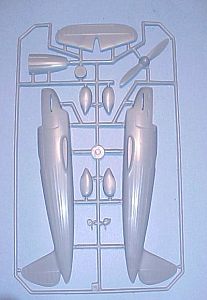 |
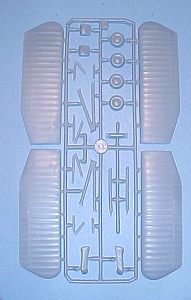 |
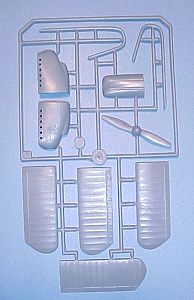 |
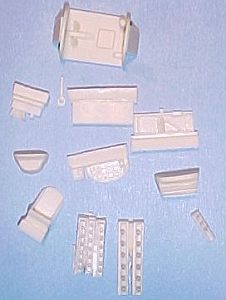 |
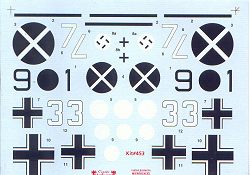 Prior to the
introduction of this kit by Classic Airframes, the only other 1/48 Ar-68E kit
available was a very good vacuform by Karo-As, which featured resin detail parts
and very crisply-molded vacuform parts. As produced, the kit is primarily the
Jumo-powered Ar-68E, with provision for substitution of the BMW VI cowling that
requires the modeler to cut off the Jumo cowl on the fuselage halves. One kit
provides decals for two pre-war Ar-68Fs a pre-war Ar-68E, and one of the two
Ar-68Es sent to Spain. The other kit provides four different markings and
camouflage patterns for Ar-68Es serving during the first year of the war as
night fighters.
Prior to the
introduction of this kit by Classic Airframes, the only other 1/48 Ar-68E kit
available was a very good vacuform by Karo-As, which featured resin detail parts
and very crisply-molded vacuform parts. As produced, the kit is primarily the
Jumo-powered Ar-68E, with provision for substitution of the BMW VI cowling that
requires the modeler to cut off the Jumo cowl on the fuselage halves. One kit
provides decals for two pre-war Ar-68Fs a pre-war Ar-68E, and one of the two
Ar-68Es sent to Spain. The other kit provides four different markings and
camouflage patterns for Ar-68Es serving during the first year of the war as
night fighters.
Detail parts, including a nice cockpit, are provided in resin. The injection-molded parts are crisp with sharp detail, reflecting the new production technology MPM has recently adopted.
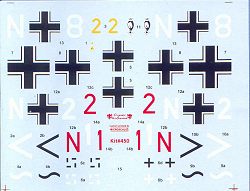 Unfortunately, the
Karo-As vacuform kit is superior in detail to this injection-molded kit, since
MPM entirely missed the fact that the upper wing of the Ar-68 was covered in
plywood over the upper surfaces to the forward spar, and over the lower surfaces
to the rear spar, while the lower wings were entirely plywood-covered. MPM has
managed to produce "hill-and-valley" fabric effect over the entire wing.
Modelers wishing to get a more accurate look to their model are advised to sand
off all the "fabric detail" of the wing parts, rescribe the various panel lines,
and recreate the fabric-covered areas with rib tape, which can be accomplished
by masking to show the ribs, then hand-painting the unmasked areas; when the
masking tape is removed, there will be a raised "rib tape" left, which is what a
fabric-covered wing looks like in reality. I have found on the two models I am doing that it
takes approximately one hour with sanding sticks to remove the inappropriate rib
detail on the wings, leaving them looking very accurate.
Unfortunately, the
Karo-As vacuform kit is superior in detail to this injection-molded kit, since
MPM entirely missed the fact that the upper wing of the Ar-68 was covered in
plywood over the upper surfaces to the forward spar, and over the lower surfaces
to the rear spar, while the lower wings were entirely plywood-covered. MPM has
managed to produce "hill-and-valley" fabric effect over the entire wing.
Modelers wishing to get a more accurate look to their model are advised to sand
off all the "fabric detail" of the wing parts, rescribe the various panel lines,
and recreate the fabric-covered areas with rib tape, which can be accomplished
by masking to show the ribs, then hand-painting the unmasked areas; when the
masking tape is removed, there will be a raised "rib tape" left, which is what a
fabric-covered wing looks like in reality. I have found on the two models I am doing that it
takes approximately one hour with sanding sticks to remove the inappropriate rib
detail on the wings, leaving them looking very accurate.
Unfortunately,
MPM made more mistakes with this kit than the wings. The entire nose for the
Ar-68F - the BMW-powered version - is completely wrong. Examined in overhead
profile, the nose tapers in, when it should instead have no taper at all but
rather be straight, to allow the upright V-8 engine to fit inside. This is
terribly apparent when comparing the built-up model to any photograph of the
Ar-68F. Interestingly, the drawings in the decal profiles show the nose in the
correct shape. An examination of the C-A He-51B - which was also BMW-powered -
shows the correct exterior shape of the upper cowling, which both aircraft
shared in common.
|
CONCLUSIONS |
If you really want an Ar-68 in your collection, the kit to get is the Ar-68E, which overall looks mostly right, other than the incorrect wings (which as stated above are an easy fix). As far as the Ar-68F is concerned, an experienced modeler who wants the model in their collection but wants it right, can accomplish that by doing some scratch-modification with putty and plastic sheet, and cutting and bending of the kit cowl - but it will be an effort.
Thanks to Classic Airframes for the review copies.
If you would like your product reviewed fairly and quickly by a site that has well over 150,000 visitors a month, please contact me or see other details in the Note to Contributors.